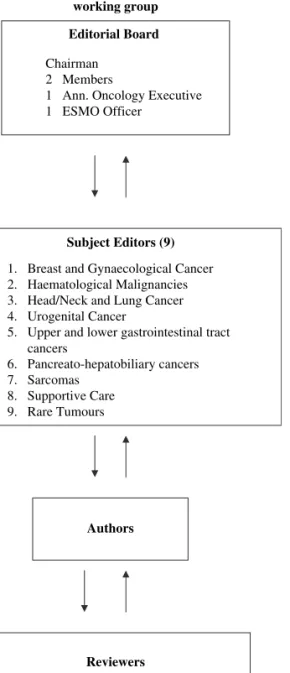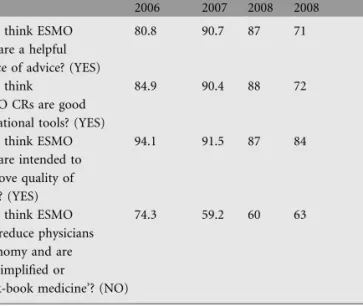Annals of Oncology 20 (Supplement 4): iv7–iv9, 2009 doi:10.1093/annonc/mdp170
editorial
ESMO Clinical Recommendations: using
the easier and faster approach to
oncology guidelines
the original idea
The European Society for Medical Oncology (ESMO) has developed and disseminated clinical recommendations to all European and non-European oncologists. ESMO’s motivation was to establish the clinical recommendations, as it was felt they were important for the future development of medical oncology and for achieving high common standards of medical practice for patients in all European countries.
The principles of the ESMO clinical recommendations were: (i) to create a set of statements for an essential standard of care; (ii) to be disease or topic oriented; (iii) to be evidence based; (iv) to have an emphasis on medical oncology; and (v) to be annually updated.
Each of the ESMO clinical recommendations provides vital, evidence-based information for physicians, including the incidence of the malignancy, diagnostic criteria, staging of disease and risk assessment, treatment plans and follow-up.
the history
1998
The original idea for the creation of the ESMO clinical guidelines came from Professor Heine H. Hansen via the Central European Task Force in 1998. In particular, he visualized the need for clinical recommendations that might be more practical in daily use. This was supported at a meeting of the ESMO national representatives, who felt that the
development of guidelines would contribute to the standing of medical oncology in Europe.
1999
Thus, in 1999 the ESMO Guidelines Task Force was constituted. Initially, the group began with a chairman (Rolf Stahel, Switzerland), a central coordinator (Lorez Jost, Switzerland), an ESMO officer (Maria Cristina Reinhart) and five members (Jørn Herrstedt, Denmark; Otto Kloke, Germany; Nicholas Pavlidis, Greece; Gunta Purkalne, Latvia; and Svetislav Jelic, Yugoslavia). During the next 5 years more members joined the task force (Jonas Bergh, Sweden; Richard Greil, Austria; Vesa Kataja, Finland; and Joa˜o Oliveira, Portugal).
2006
Since 1 January 2006 the Guidelines Task Force has been an independent group—the ESMO Guidelines Working
Group—under the new ESMO Education Committee structure. It consists of: (i) an editorial board with a chairman (Nicholas Pavlidis, Greece), three members (Rolf Stahel, Switzerland; Heine Hansen, Denmark; and Svetislav Jelic, Serbia), an Annals of Oncology executive (Lewis Rowett, UK) and an ESMO Coordinator (Paola Minotti, Switzerland), (ii) the seven subject editors responsible for the topics, the authors, the revision of the manuscripts and the presentation and discussion of final drafts with the editorial board (M. Castiglione, Switzerland; J. Oliveira, Portugal; E. Felip, Spain; V. Kataja, Finland; M. Dreyling, Germany; L. Jost, Switzerland; and F. Roila, Italy), (iii) the assigned authors and (iv) the five preselected reviewers per topic who have all been ESMO Faculty members.
2008
In 2008 the Guidelines Working Group made some changes and now consists of: (i) an editorial board with a chairman (Nicholas Pavlidis, Greece), two members (Rolf Stahel, Switzerland and Heine Hansen, Denmark), an Annals of Oncology executive (Lewis Rowett, UK), an external medical oncologist coordinator (George Pentheroudakis, Greece) and an ESMO Coordinator (Roberta Vecchi, Switzerland); (ii) nine subject editors: Monica Castiglione—Switzerland for breast and gynaecological cancer, Martin Dreyling—Germany for haematological malignancies, Enriqueta Felip—Spain for lung and head/neck cancer, Paolo Casali—Italy for sarcomas, Vesa Kataja—Finland for genito-urinary cancer, Andres Cervantes—Spain for gastrointestinal cancer, Fausto Roila—Italy for supportive care, Svetislav
Jelic—Serbia for liver, pancreatic cancer and neuroendocrine tumours and George Pentheroudakis—Greece for rare tumours; (iii) the assigned authors and (iv) the five preselected reviewers per topic on a multidisciplinary platform (Figure 1). Figure 2 demonstrates the functioning network of the ESMO Guidelines Working Group
Nearly 9 years after the inception of the ESMO Guidelines Task Force and up to 2009, 54 clinical recommendations were freely available on the ESMO website and in Annals of Oncology.
the evaluation of dissemination of
ESMO Clinical Recommendations
During the last several years ESMO Clinical Recommendations have been disseminated and implemented through different methodological tools.
We continuously evaluate the results of these tools in order to access the diffusion of ESMO Clinical Recommendations to the oncological community.
These tools are: (i) the data from the annual downloads of Oxford Journals usage statistics through the supplementary ªThe Author 2009. Published by Oxford University Press on behalf of the European Society for Medical Oncology.
issues of Annals of Oncology, (ii) the evaluation scoring from the interactive ESMO Guidelines sessions conducting during the ESMO Congresses and (iii) the results from a questionnaire (with 10 questions related to ESMO Guidelines evaluation) distributed to ESMO Congresses and ECLU participants.
downloads
The extracted data from the downloads for the last 2 years were the following:
(i) May 2007–May 2008: 45 066 and (ii) May 2008–October 2008: 60 330 downloads (Table 1). The three most commonly downloaded tumours were ‘primary breast cancer’, ‘metastatic breast cancer’ and ‘non-small-cell lung cancer’.
interactive ESMO sessions
The evaluation scoring (average score) of the five interactive sessions during the last five ESMO Congresses were as follow: Hamburg (2000): 3.78, Nice (2002): 4.05, Vienna (2004): 4.07, Istanbul (2006): 4.24 and Stockholm (2008): 4.48 (Table 2).
the questionnaire
Analysis of the questionnaire data from the 31st and 32nd ESMO Congresses and the2007 and 2008 ECLU conferences
The structure of the ESMO Guidelines working group
Editorial Board
Chairman 2 Members
1 Ann. Oncology Executive 1 ESMO Officer
Subject Editors (9)
1. Breast and Gynaecological Cancer 2. Haematological Malignancies 3. Head/Neck and Lung Cancer 4. Urogenital Cancer
5. Upper and lower gastrointestinal tract cancers 6. Pancreato-hepatobiliary cancers 7. Sarcomas 8. Supportive Care 9. Rare Tumours Authors Reviewers
5 ESMO Faculty Members per Topic on A multidisciplinary platform
Figure 1. The structure of the ESMO Guidelines Working Group.
The Operational Network of ESMO GLWG
Editors Subject Editor Author Subject Editor Reviewer Subject Editor Editors Subject Editor Author Subject Editor
Figure 2. The operational network of the ESMO Guidelines Working Group.
Table 1. Downloads extracted data
Period No. of downloads May 2007–May 2008 (12 months) 45 066
May 2008–October 2008 (6 months) 60 330
Table 2. Evaluation of ESMO interactive GL sessions Date and place
of congress
Topics discussed Average score (1–5) 2000, Hamburg Colon cancer 3.78
NSCLC Testicular cancer
2002, Nice CUP 4.05 Ovarian cancer
Prostate cancer
2004, Vienna Advanced breast cancer 4.07 Follicular lymphoma
Rectal cancer
2006, Istanbul Breast cancer (adjuvant) 4.24 NSCLC
Hodgkin’s lymphoma
2008, Stockholm Thrombosis and cancer 4.48 Pregnancy and cancer
Gastric cancer
editorial
Annals of Oncologyshowed that the majority of the European and non-European oncologists favor ESMO Clinical Recommendations (Table 3).
the perspectives
The ESMO Guidelines Working Group feels that the ESMO Clinical Recommendations have been widely accepted by the oncological community.
It should also be emphasized that ESMO Clinical Recommendations have already been translated into nine languages (French, German, Italian, Spanish, Portuguese, Russian, Japanese, Chinese and Greek).
Since last year the ESMO Guideline Task Force decided to include a number of clinical recommendations as a product of International Consensus Conferences. These recommendations will be larger in context and more detailed than the previously existing ESMO Guidelines.
In addition, the ESMO Guidelines Working Group intends in the near future to increase the size of several clinical recommendations, especially those of the most common tumours (the big killers), due to a continuous huge amount of new information.
N. Pavlidis1*, H. Hansen2& R. Stahel3 1
Department of Medical Oncology, Medical School, University of Ioannina, Greece,2The Finsen Center, Copenhagen University Hospital, Denmark,3University Hospital of Zurich, Clinic and Polyclinic for Oncology, Zurich, Switzerland *Correspondence to: npavlid@uoi.gr
literature
1. Pavlidis N, Hansen H, Stahel R. ESMO Clinical Recommendations: a practical guide for medical oncologists. Ann Oncol 2007; 18: 1759–1763.
2. Pavlidis N. Towards a convenient way to practice medical oncology. Ann Oncol 2007; 18 (Suppl 2): ii3–ii4.
3. Pentheroudakis G, Stahel R, Hansen H, Pavlidis N. Heterogeneity in cancer guidelines: should we eradicate or tolerate?. Ann Oncol 2008; 19: 2067–2078.
Table 3. Data from ESMO Guidelines questionnaire analysis (%) 31st ESMO Istanbul 2006 ECLU Lugano 2007 ECLU Lugano 2008 32nd ESMO Stockholm 2008 Do you think ESMO
CRs are a helpful source of advice? (YES)
80.8 90.7 87 71
Do you think ESMO CRs are good educational tools? (YES)
84.9 90.4 88 72
Do you think ESMO CRs are intended to improve quality of care ? (YES)
94.1 91.5 87 84
Do you think ESMO CRs reduce physicians autonomy and are oversimplified or
‘cook-book medicine’? (NO)
74.3 59.2 60 63
Annals of Oncology

